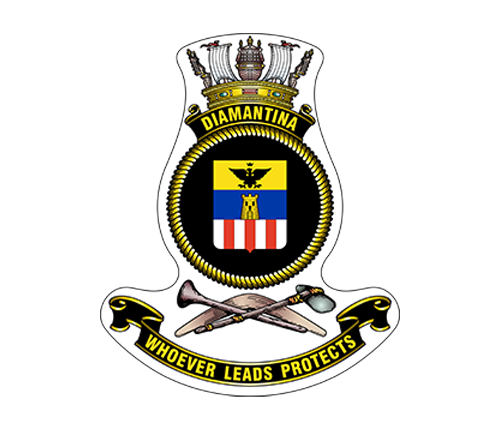Commissioned on 4 May 2002, HMAS Diamantina (II) is the fifth of 6 Huon Class minehunter coastal (MHC) vessels. The Huon Class MHC was designed in Italy as the Gaeta Class for the Italian Navy. The Royal Australian Navy (RAN) Huon Class includes modifications to suit Australian conditions such as improved accommodation and mine hunting capabilities.
The Huon Class minehunters are named after Australian rivers. Diamantina is the second RAN ship to carry the name. HMAS Diamantina (I) was a River Class frigate that was in service from 1945 to 1980. It saw action during World War II, and from 1959 to decommissioning was employed as an oceanographic survey vessel.
The Huon Class features a unique hull design, shock resistance and an inherently low magnetic signature, allowing the ships to operate in hostile mine environments. Each hull was designed with no ribs, frames or stiffeners to avoid local stress points that could separate under shock conditions.
For mine countermeasure operations, the ships are fitted with a variable depth sonar capable of detection ranges in excess of 1,000 metres ahead of the ship. When a mine is detected in a water column or on the seabed, the ship will 'hover' about 200 metres from the contact. Mine disposal vehicles or clearance divers are deployed to investigate and neutralise the mine threat.
Each ship is fitted with a pair of electrically powered Bofors Underwater Systems Double Eagle mine disposal vehicles. These are equipped with a searchlight, closed-circuit low light television camera and an on-board close range identification sonar. Commands are relayed via a fibre optic link inside the vehicle's tether, which also relays sensor images for display on the ship's multifunction console in the operations room.
Each Double Eagle vehicle is fitted with either a disposal charge slung beneath or an explosive or mechanical cutter designed to sever the wire rope or chain holding moored mines.
Specifications
- Class: Huon Class
- Type: minehunter, coastal (MHC)
- Role: mine warfare
- Pennant: M86
- International callsign: VLTH
- Motto: Whoever Leads Protects
- Home port: HMAS Waterhen
- Builder: ADI Newcastle
- Launched: 2 December 2000
- Commissioned: 4 May 2002
- Displacement: 732 tonnes
- Length: 52.5 metres
- Beam: 9.9 metres
- Draught: 3 metres
- Speed: 14 knots
- Range: 1,600 nautical miles
- Crew: 46
- Machinery:
- 1 Fincantieri GMT diesel
- 3 Isotta Fraschini 1300 diesels
- 3 electrohydraulic motors
- Riva Calzoni retractable/rotatable APUs
- Guns: one MSI DS30B 30 mm
- Physical countermeasures:
- 2 Bofors SUTEC Double-Eagle Mk 2 mine disposal vehicles
- 2 MEL Aviation Super Barricade chaff launchers
- Electronic countermeasures: AWADI Prism
- Radars: Kelvin Hughes 1007
- Sonars: GEC-Marconi Type 2093
- Combat data systems: GEC-Marconi Nautis 2M
- Weapon control systems: Radamec 1400N optronic surveillance system

Function
Coastal minehunter